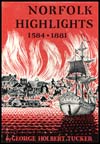Chapter 26
Norfolk Theater History - Part II
Although theatrical performances were given fairly frequently in pre-Revolutionary Norfolk in "Capt. Newton's Great Room" and in Norfolk's first known theater, a converted pottery on King's Lane near the Elizabeth River, it was not until after the Revolution that the borough's theatrical life became really active.
As early as 1790, Norfolkians were flocking to see "The Irish Widow" and "The School for Scandal." But there was no regular playhouse in Norfolk until 1793, when a former warehouse on Calvert's Lane was used for that purpose.
This makeshift theater was operated by Thomas Wade West and John Bignall, two well-known American actor impresarios of their day who were also responsible for the erection of Norfolk's first regular theater in 1795 on property that had been purchased by them on July 12, 1792.
The building was of brick and stood midway of the block on the east side of Fenchurch Street between East Main and Bermuda streets. On its stage, David and Elizabeth Arnold Poe, the parents of Edgar Allan Poe, acted for several seasons; John Howard Payne, the author of "Home Sweet Home," played "Hamlet" and other tragic roles as a youth; and Junius Brutus Booth, the father of John Wilkes Booth, Lincoln's assassin, appeared in Shakespeare's "Richard III" and other meoldramatic roles in November of 1821.
Two years later the building was sold to the Methodist Protestant congregation and on March 6, 1845, it was destroyed by fire.
Norfolk was without a regular theater until 1839, when the Avon Theater was built. It stood on the site of the former Norfolk police headquarters, just behind the present MacArthur Memorial, and was an elegant building with an impressive portico supported by six massive Doric columns, with a bust of Shakespeare in its pediment. It burned in February of 1850.
Norfolk's next theater was the Mechanic's Hall on the south side of Main Street, a "Tudor Gothic" building that was first opened in 1850. It was used for years as a recital hall by travelling musicians and also as a place for political rallies. It ended its career as the Gaiety Theater, a burlesque house, and was torn down in 1960.
The Norfolk Varieties or Church Street Opera House was next. It was opened in 1856, and stood on the west side of Church Street between the present Plume Street and City Hall Avenue. The finest actors and singers of their day appeared on its stage during its long career, but there were times when the performances were not up to par. For instance, in reviewing a travelling opera company in 1856, a Norfolk newspaper critic wrote:
"Such demoniac howlings were never heard outside of Pluto's dreary kingdom, and we can only compare the entire performance to a midsummer night when all the dogs and cats are loose."
The Church Street Opera House held its own until 1880, when the Academy of Music, the finest theater in the South at that time, was erected on Main Street on the present site of the south entrance of the Selden Arcade.
The Academy was the most elegant theater ever erected in Norfolk. Its great electrically lighted chandelier, the first of its kind in the city, that hung from an elaborately frescoed ceiling in which medallion portrais of Shakespeare, Racine, Beethoven, Goethe, Mozart, Haydn, Schiller and Mendelssohn were inserted, was one of the major attractions of the Norfolk of its era.
Its spacious stage was also the glittering showcase for every great actor, concert artist, vocal artist and opera company that visited Norfolk for almost half a century.
Finally, on April 4, 1930, the Academy, that had been degraded to a cheap movie house, after which it was boarded up during the Great Depression for lack of patrons, was destroyed by fire.
Chapter
27
Norfolk's Presbyterian Beginnings
Norfolk Highlights 1584 - 1881

See the "Table of Contents" for links to every chapter in Norfolk Highlights 1584 - 1881 by George Holbert Tucker.
